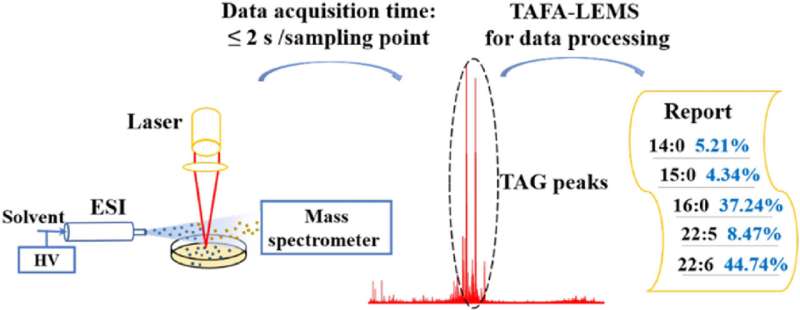This article has been reviewed according to Science X's editorial process and policies. Editors have highlighted the following attributes while ensuring the content's credibility:
fact-checked
trusted source
proofread
High-throughput mass spectrometry platform enables in-situ screening of fatty-acid-producing strains

Mass spectrometry (MS) is a valuable analytical tool for high-throughput screening due to its speed, high resolution, and sensitivity. Recently, researchers from the Qingdao Institute of Bioenergy and Bioprocess Technology (QIBEBT) of the Chinese Academy of Sciences (CAS) have developed a high-throughput MS platform that enables in-situ screening of fatty acid-producing strains.
The results were published in Talanta.
The proposed platform uses laser ablation electrospray ionization mass spectrometry (LAESI-MS) for direct profiling of triglyceride (TAG) species in colony cellular lipid droplets of Aurantiochytrium sp. The ionization source, one of the core components of the MS platform, integrates a high-energy laser module and an electrospray module.
The laser module serves to ablate colony cells and desorb molecules from cellular lipid droplets, generating molecular plumes, while the electrospray module ionizes the molecular plumes produced by laser ablation.
In the workflow of the platform, the laser source is precisely focused on a single colony from the agar plate. The laser energy ablates and desorbs the colony cells, resulting in the generation of a molecular plume. Subsequently, the plume is ionized by the electrospray, thereby converting the molecules into ions. Finally, the resulting ions are analyzed using a mass spectrometer.
This MS platform enables rapid, highly effective sampling and ionization of TAG molecules. The distribution of fatty acids is estimated by TAG intensities in cellular lipid droplets of colonies on agar plates. Notably, it has realized a fast sampling rate of ≤ 2 s per sampling point and ≤ 13.69% relative standard deviation (RSDs) of the relative contents of fatty acids.
The MS platform has been applied to analyze Phaeodactylum tricornutum and Yarrowia lipolytica strains, demonstrating its capability for high-throughput screening, which makes it an efficient tool for fatty acid biomanufacturing.
More information: Huan Liu et al, A high-throughput platform enables in situ screening of fatty acid-producing strains using laser ablation electrospray ionization mass spectrometry and a Python package, Talanta (2023). DOI: 10.1016/j.talanta.2023.125234
Provided by Chinese Academy of Sciences





















